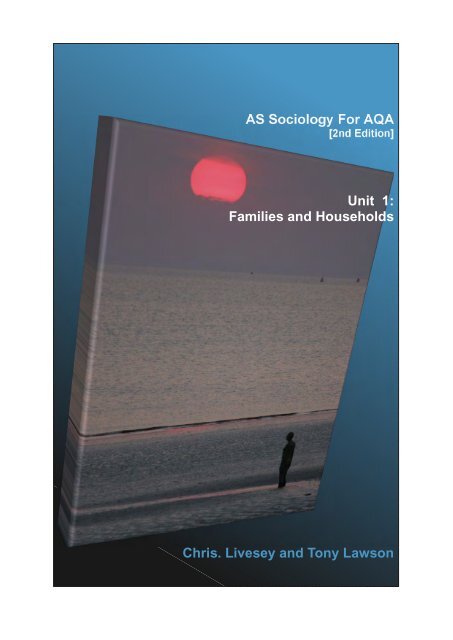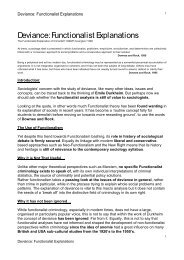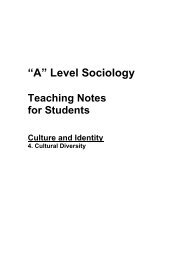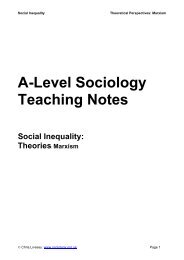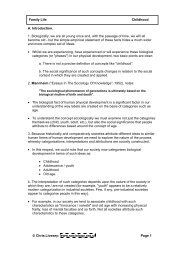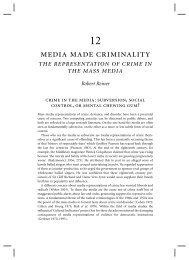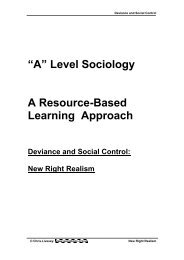AS Sociology for AQA: 2nd edition
AS Sociology for AQA: 2nd edition
AS Sociology for AQA: 2nd edition
Create successful ePaper yourself
Turn your PDF publications into a flip-book with our unique Google optimized e-Paper software.
<strong>AS</strong> <strong>Sociology</strong> For <strong>AQA</strong>[<strong>2nd</strong> Edition]Unit 1:Families and HouseholdsChris. Livesey and Tony Lawson
Unit 1:Families and HouseholdsContents1. The relationship of the family to the social structure andsocial change, with particular reference to the economy and tostate policies.2. Changing patterns of marriage, cohabitation, separation,divorce, child-bearing and the life-course, and the diversity ofcontemporary family and household structures.2233. The nature and extent of changes within the family, with referenceto gender roles, domestic labour and power relationships.434. The nature of childhood, and changes in the status of children inthe family and society.575. Demographic trends in the UK since 1900; reasons <strong>for</strong>changes in birth rates, death rates and family size.66
5. Demographic trends in the UK since 1900; reasons <strong>for</strong> changes in birthrates, death rates and family size.Demographic Trends: ObservationsWe can begin by thinking about birth rates, death ratesand family size in the UK during the 20 th century in arelatively discrete way; that is, we can identify a numberof general trends <strong>for</strong> each in isolation from one another(even though, as we will see, it is probably moresociologically useful, once we’ve established basictrends, to understand how these demographic factorsare both interrelated and the general consequencesthis interrelationship has <strong>for</strong> family life).Birth TrendsAccording to Chamberlain and Gill (2005), the totalnumber of live births in the UK fell from a peak of justover 1.1 million at the start of the 20 th century to around700,000 at the close of the century. Although live birthshad risen to around 720,000 by 2005, Self and Zealey(2007) note this represents “34% fewer births than in1901 (and 20% fewer than 1971)”. Statistically,there<strong>for</strong>e, the general picture is one of an overalldecline in UK births, even when we allow <strong>for</strong> the major“data spikes” (significant increases in live births) thatfollowed both the 1 st and 2 nd World Wars (“babybooms”) and a further spike in the mid-1960’s as thepost-war baby boom worked it’s way through thegeneral population.In terms of birth rates the general picture is one ofsimilar, if perhaps more-pronounced, decline.Live Births per 1000 UK PopulationSource: Tiffen and Gittins (2004)1900 291950 162000 12Over the past 40 years, changing patterns of childbearingin our society can be summarised in terms ofthe ideas that:General fertility has substantially declined, includingboth the number of live births and the birth rate.Family size has declined from an average of 3 toaround 1.6 children.Motherhood: The average age at which women havetheir first child is increasing.Births outside marriage now account <strong>for</strong> nearly halfof all births - a substantial increase over 40 years ago.Death TrendsNotwithstanding the existence of a couple of notable“data spikes” between 1914 -18 and 1940-45 (so-called“death booms” reflecting the effects of World Wars), thenumber of people dying each year in the UK throughoutthe 20 th century has, as Penneck and Lewis (2005)note, remained roughly constant. At the start of thecentury, <strong>for</strong> example, there were around 640,000deaths per year, while this figure had fallen slightly toaround 605,000 deaths by the century’s close. Thesefigures, however, hide a rather different story once weallow <strong>for</strong> population increases (around 20-odd million)over the course of the century. As with birth trends,there<strong>for</strong>e, we get a more valid picture by looking at:Death rates rather than raw numbers::Deaths per 1000 UK PopulationSource: Penneck and Lewis (2005)1900 162000 10As this more-valid <strong>for</strong>m of statistical analysisdemonstrates, the general trend over the past onehundred years in the UK is <strong>for</strong> a substantial fall in thedeath rate.Module Link Research MethodsWhen analysing any <strong>for</strong>m of demographic data thevalidity of such analysis will normally be increasedby looking at rates (the number per 1000 in apopulation) rather than raw numbers. By way offurther example, a case in point here is theanalysis of crime statistics.
<strong>AS</strong> <strong>Sociology</strong> For <strong>AQA</strong>One way to check the validity of birth rate statistics is tocompare themwith statisticaltrends <strong>for</strong>average (mean)family size – andwhen we do wefind that, aspredicted, therehas been asteady, long-term,decrease inaverage familysize. Diamond(2007), <strong>for</strong>example,identifies thefollowing changesin the fertilityrate (the numberof children bornper woman) fromthe mid-19 thcentury to thepresent:Family Size TrendsUK Fertility RateSource: Diamond (2007)YearAct1901 3.51911 2.81921 2.41931 1.81941 1.81951 2.41981 2.61971 2,01981 1.71991 1.82001 1.6Grenham (1995)summarises thegeneral trends in2005 1.7UK fertility / average family size in the following terms:Trends in UK Fertility / Average Family SizeSource: Grenham (1995)1870s1930s1950s1960s1980s2000sBetween 5 and 6 children.2 childrenPost 2 nd World War baby boom creates anincrease in average family size.“Baby bust” – gradual decline in fertilityrates until 1970s.Continuing decline in fertility rates andgradual fall in average family size(between 1.8 and 1.6 children).Slight rise in fertility and average familysize (product once more of post-war babyboom as the grandchildren of the originalbaby-boomers start their own families).There are a couple of interesting points we can note inrelation to fertility / average family size. Firstly, thesensitivity of these trends to social changes - the mostobvious of which is the <strong>2nd</strong> World War and the “rippleeffect” this has produced in terms of “Baby Booms” and“Baby Busts” (but we could also note changes like theintroduction of reliable female contraception in the1960s as a further example of important socialchanges).Secondly, Grenham notes that the long-term decline infertility / average family size is something that “hasFamilies and Householdsbeen shared by the rest of the industrialised world.”.This suggests that any explanation <strong>for</strong> the generaldecline in fertility needs to take into account that thisphenomenon is not unique to the UK.It’s possible to specify a range of reasons that, in aloneand in combination, have contributed to the respectivefalls in birth rates, death rates and family size.be noted:Tried and Tested(a) Explain what is meant by “birth rate” (2 marks).(b) Summarise UK trends in fertility and family sizeover the past century.(4 marks).Demographic Trends: ExplanationsBirth TrendsA number of explanations <strong>for</strong>changes in UK birth rates overthe course of the 20 th century canWar / Economic Depression: As we’ve suggested, UKbirth rates have been sensitive to both war andeconomic depression (such as that seen in the 1930s).During the 2 nd world war, <strong>for</strong> example, the birth rate fellsignificantly – symptomatic of a general reluctance tomarry and start families during the period of violentupheaval and uncertainty. Tiffen and Gittins (2004)note how this relationship holds true across just aboutevery developed industrial nation during the 20 thcentury.Birth Control: They also suggest a couple of specificreasons <strong>for</strong> a decline in birth rates over the past 40 orso years; firstly, the increased availability andreliability of contraception (the female contraceptivepill, <strong>for</strong> example, entered mainstream use in the mid1960s) and, secondly, the legalisation of abortion(available free and on demand under the NationalHealth Service) in 1967. For Botting and Dunnell(2000), legal abortions have “contributed to the fallingbirth rates” amongst various age groups. Over thepast 25 years, <strong>for</strong> example, 35% of all conceptions<strong>for</strong> the 18 - 19 age group ended in terminations.Overall, around 20% of all conceptions are currentlylegally terminated. Although birth control techniquesare significant reasons <strong>for</strong> the declining birth rate theydon’t, of course, explain why people want to limit thesize of their family in the first place.To explain this, there<strong>for</strong>e, we need to note a furtherset of explanations.Lifestyle Choices and ChangesOne feature of the latter part of the 20 th century, asAbercrombie and Warde (2000) note, has been anincreased female participation in the work<strong>for</strong>ce, both aspart of what the Rapoport and Rapoport (1969)termed “dual-career families” - both adult partnersbeing economically active at the same time and67 © www.sociology.org.uk
<strong>AS</strong> <strong>Sociology</strong> For <strong>AQA</strong>there<strong>for</strong>e contributing dual incomes to the household /family) – and as single career men and women.Part of this changing economic process involves adelay in the average age of 1st marriage and aconsequent delay in conception and childbirth. This, asthe Office <strong>for</strong> National Statistics (2005) notes,involves a change in fertility patterns: “In 2004, <strong>for</strong> thefirst time, the fertility rate of women aged 30-34overtook that of women aged 25-29”. This trendtowards “later family <strong>for</strong>mation” goes part-way toexplaining a general decline in birth rates (given thatwomen have a limited fertility span - usually estimated,<strong>for</strong> official statistical purposes, at ending around 45years of age – and are unlikely to have large familiesduring their 30s / early 40s).Childbirth within marriage is, of course, only part of thestory; as Self and Zealey (2007) note, 42% of UK livebirths now take place outside marriage (to single orcohabiting parents) and these statistics tell us little ornothing about why the general birth rate has remainedlow. We need, there<strong>for</strong>e, to consider a further reason:Childlessness: An interesting feature of modernhouseholds is both the number of childless individuals /couples and the general increase in childlessness overthe past half century (as evidenced by the followingtable):Childless WomenSource: Adapted from Self and Zealey(2007) and Summerfield and Babb (2004)Year Percentage childless at age 251969 111975 121995 252000 25Families and Households2. Financial Pressures: When we think aboutconcepts like risk and security we are perhaps gettingcloser to explaining both current birth rates and, byextension, the trend towards smaller family sizes. Asignificant consideration here is the:Cost of children, summarised by the studies in thefollowing table:Average Cost of Children:Selected StudiesStudy£ per week per childDavies and Joshi (1999) 117Family ExpenditureSurvey (2000)Pregnancy and Birthmagazine (2001)Although these figures raise questions of both reliabilityand comparability (different costs are included andexcluded by different studies), they do, perhaps, giveus a general view of potential childcare costs – andwhile it’s arguable as to whether potential parentsrationally calculate the “costs of children” in any specificway, they will have, at the very least, a general pictureof costs in a couple of areas:Education: The introduction of compulsory educationpost-1944 added to childcare costs by extending theperiod of “childhood dependency” (the school leavingage was raised to 16 in 1972). It also meant restrictionswere placed on the economic activity (and income) ofchildren. More recently, the introduction of Universitytuition fees has added to (mainly middle and upperclass) family costs.5264Middleton et al (2002) 49Self and Zealey (2007) note that “The proportion ofwomen reaching the end of their childbearing years(age 45) who remained childless” rose from 11%in1985 to 18% in 2005 and McAllister and Clarke(1998) identified two main reasons that help explainwhy people “choose childlessness” (and perhapsprovide further pointers to understanding why womenare having fewer children):1. Risk: ”People choosing lives without children heldconventional views about partnershipsand parenting - but were averse totaking risks”. This idea, in turn, wasrelated to a couple of further points:• Life course: “For women living alone,single parenthood was not considered aviable option” and highly qualifiedcareer women are more likely to remainchildless.• Security: Parenthood was identifiedwith disruption, change and poverty; the childless When looking at how something like “childcare costs” are calculatedby different studies we always need to ask whether “like is beingchose independence over the constraints of childcare compared with like” (a reliability problem) - in other words, do differentand material security over financial risk.studies include the different costs under “childcare”?68 © www.sociology.org.uk
<strong>AS</strong> <strong>Sociology</strong> For <strong>AQA</strong>Work: One parent is effectively removed from paidwork during pregnancy and pre-school childdevelopment (although both private and state nurserycare is available, the cost of such care has to be off-setagainst the earning power of the parent).Aside from the general “costs of children” Grenham(1995) notes a couple of additional child-related factorsin the explanation <strong>for</strong> declining birth rates and familysize.Firstly, he argues, contemporary families have “Lessneed <strong>for</strong> children as a protection against old age andillness” and, secondly, <strong>for</strong> many families there is acompetitive trade-off between having children andmaintaining a higher general standard of living.Families and Householdsand Wales are currently to mothers born outside the UK– the birth rate would be significantly lower than itcurrently stands without this intervening variable) is analmost automatic consequence of an original birth ratedecline.As with birth rates, the generalDeath Trends trend in the UK throughout the20 th century has been <strong>for</strong> adecline in death rates. Whilemacro events like the 1 st and 2 nd World War increasedthe general death rate at various points, Chamberlainand Gill (2005) argue that the stability of crude deathrates (defined by Grenham (1995) as “the number ofdeaths in a year expressed as a percentage of theaverage population”) is a consequence of two basicfactors: Firstly the a<strong>for</strong>ementioned increase in the sizeof the population and, secondly, “the decline in mortalityand its increasing concentration at older ages”.Penneck and Lewis (2005) note twodistinct phases in the age distribution ofdeath rates throughout the 20 th century.In other words, theNew car or new child?money that wouldhave been spent on raising children is available tospend on consumer goods and services instead and indual-income families the decision to have a childpotentially means the loss of one partner’s income. Wecould also note Tiffen and Gittins’ (2004) argumentthat many women now have different aspirations toboth their mothers and grandmothers, in the sense theyare less likely to accept personal and social identitiesbuilt around the home and motherhood.Finally, the explanations <strong>for</strong> declining birth rates we’vejust outlined are framed in terms of the various wayspeople act (such as using contraception or wanting tomaintain a particular lifestyle and living standard) orreact (the experience of life during wartime, <strong>for</strong>example). An alternative reason <strong>for</strong> this phenomenoncan be framed in terms of the historical characteristicsof successive:Firstly, by the end of the century manymore people are surviving into their 60sand secondly, far higher numbers arenow surviving into “later old age”:Average Life Expectancy (years) at Birthby SexSource: Self and Zealey (2007)Year Make Female1901 34 491951 64 701981 72 782001 77 81We can outline reasons <strong>for</strong> this general trend in termsof two, not necessarily unrelated, broad categories(medicine and public health).Birth cohorts: We can relate the idea of childlessnessto the fact of increased life expectancy <strong>for</strong> both menand women. Where (crude) birth rates are calculated asan average <strong>for</strong> all women, Tiffen and Gittins (2004)note that if “a higher proportion of the population livewell beyond the normal childbearing years of 15–45,the birth rate falls <strong>for</strong> that reason alone”. Similarly,Johnson (1993) points-out that a decline in the birthrate <strong>for</strong> any given birth cohort (“a group of people bornin a given year”) has a cumulative effect - successivebirth cohorts are smaller than the one be<strong>for</strong>e. Theeffect, he suggests, “is <strong>for</strong> the number of…children insociety to decline, followed by the number of youngadults as the lower fertility rate works its way up theage structure”.In other words long-term birth rate decline, althoughaffected by short-term factors such as war orpopulation migration (Office <strong>for</strong> National Statistics(2005) figures show around 20% of births in EnglandMedicine and Health CareSelf and Zealey (2007) note that “developments inmedical technology and practice” help to explaindeclining death rates and it’s possible to identifyexamples of medical developments that have improvedpeople’s chances of both staying alive and enjoying arelatively long life span. These include:Vaccination against diseases like polio and diphtheriathat steadily reduced their death toll amongst infantsand children. In 1913, <strong>for</strong> example, the Department ofHealth (2004) notes there were around 8,000 deathsattributed to diphtheria; over the past 20 years it hascaused just 2 deaths.69 © www.sociology.org.uk
<strong>AS</strong> <strong>Sociology</strong> For <strong>AQA</strong>Medicines: The development of antibiotics, <strong>for</strong>example.Practices: Developments in surgery (such as heart bypassoperations) have meant those who would, in<strong>for</strong>mer times, have died can continue to lead arelatively active life.Prevention: Penneck and Lewis (2005) argue that “Inthe first half of the 20th century, advances in theprevention of infectious and respiratory diseases led toa great reduction in infant and child mortality” –something confirmed by the following table:UK Infant Mortality: rates per 1,000live birthsSource: Self and Zealey (2007)YearRate1921 841945 491956 252005 05Self and Zealey (2007) attribute the fall in infantmortality rates – “one of the major factors contributingto an overall increase in life expectancy” – to three“areas of improvement”:• Diet and Sanitation.• Antenatal, postnatal and medical care.• Vaccines and immunisation programmes.Families and HouseholdsWhile advances in medicine and health care are clearlysignificant, of arguably more value in terms ofincreasing general levels of life expectancy are a raft ofimprovements in the physical environment. Exampleshere include:• Housing - such as slum clearance and thedevelopment of cheap, good quality, public housingafter the 2 nd World War.•Public sanitation - this includes, <strong>for</strong> example, steps toensure public exposure to sewage / waste isminimised as well as things likeensuring peopleunderstand basicsanitation principles(how, <strong>for</strong> example,disease can bespread byunsanitorypractices).• Sewage / wastedisposal - includingimprovements inthe treatment ofsewage / waste.Public Health MeasuresThe development ofclean water supplieshas been one of the keyfactors in theimprovement of publichealth in the UKduring the 20thcentury• Clean water: The Department of Health (2004)suggests that, over the past century, “the two mostsignificant contributions to better health have beenclean water supplies and vaccines”.To this general list we could also add things like thedevelopment of the Welfare State (post-1944) and itsprovision <strong>for</strong> a:• National Health Service involving an integratednetwork of General Practitioners and hospitals.Module LinkStratification and DifferentiationAn interesting point to note here is that despite theNational Health Service and the provision of freehealth care “on demand”, major inequalities stillpersist in infant mortality rates between socialclasses:• National Insurance and Pension provisions thatensured some level of financial security <strong>for</strong> the retired.Module LinkWealth, Poverty and WelfareTo explore developments in the Welfare State inmore detail, see the section on “WelfareProvision”UK Infant Mortality rates per1,000 live births, 2005Source: Self and Zealey (2007)Occupational ClassClass 1: Large employers /higher managerial occupationsRateClass 5: Routine occupations 6All occupations 53Lifestyle Choices and ChangesTowards the end of the 20 th century we can note subtle,but significant, developments in these areas in thesense that there is a greater awareness and recognitionof a range of “behaviours” that contribute to bothindividual health and longevity. Examples here include:Smoking: Penneck and Lewis (2005), <strong>for</strong> example,note the “dramatic reduction in death from circulatorydiseases (in part caused by the decline in smoking)”.70 © www.sociology.org.uk
<strong>AS</strong> <strong>Sociology</strong> For <strong>AQA</strong>Families and HouseholdsCleaner air: The Clean Air Acts (1956 and 1993), <strong>for</strong>example, placed restrictions on smoke emissions (bothfrom private and industrial premises).Health Education – a greater awareness, <strong>for</strong> example,of the importance of balanced diets, daily fruit andvegetable intakes, limits on alcohol intake and the like.Finally, a couple of significant ideas we need to note inthe context of death rates are:Poverty: The poor generally suffer greater healthproblems (and, as statistics <strong>for</strong> life expectancy show,die younger) than those who are not poor. The generalUK trend throughout the 20 th century has been <strong>for</strong> thepopulation, on average, to experience higher levels ofaffluence and, in consequence, there were fewerpeople living in desperate poverty at the end of thecentury than at the beginning. We would, there<strong>for</strong>e,expect to see a decline in death rates to reflect the factfewer people suffered the life-threatening effects ofpoverty.demographic transition theory suggests the trendswe’ve identified are part and parcel of a generaldemographic change that occurs in the transitionbetween four basic social stages in a society’s historicaldevelopment:Stage 1:Pre-industrial (or pre-modern) societytrans<strong>for</strong>ms into:Stage 2:Early industrial (or early-modern) societytrans<strong>for</strong>ms into:Stage 3:Late industrial (or late-modern) societytrans<strong>for</strong>ms into:Stage 4:Post-industrial (or postmodern) society.Affluence: On the other hand,increasing prosperity bringsinto play a different range oflife-threatening problems –obesity, <strong>for</strong> example, is now amajor cause of prematuredeath in the UK (around30,000 people die each yearfrom health problems relatedto obesity).Thus far we’ve examined birthand death rates in relativeisolation from each other andwhile it’s possible to see falling birth and death rates asunconnected, it’s also possible to suggest thisrelationship (or correlation) is not coincidental; in otherwords, to argue that changes in both are related towider processes of social change – an idea that isgiven some credence by the fact that this phenomenonis not unique to the UK.As Tiffen and Gittins (2004) demonstrate, the trendthroughout the industrialised nations of theworld (Western Europe, Scandinavia, Japan,Australia, the United States and so <strong>for</strong>th)during the 20 th century has been consistentlythe same: falling birth, death and fertility ratescoupled with rising life expectancy.Demographic TransitionTime ScaleMainEconomicActivityTypes of Society (Britain): Selected CharacteristicsPre-Modern Early-Late Modern Post-ModernPre-16 thcenturyPre-industrial(Agricultural)16 th - late 20 th century Late-20 thcentury topresentIndustrial(Machine-based massproduction)Post-industrial(Goods andservices)Scale Local National / International GlobalBroad social transitions in UK society: Mid-16th to 21st centuryThe following table demonstrates how, according toMcFalls (2003) birth, death and population ratescorrelate with the above stages across all industrialisednations.Demographic Transitions: All IndustrialisedCountriesSource: McFalls (2003)Birth rate Death rate PopulationStage 1 High High LowStage 2 High Falling Rapidly GrowingStage 3 Falling Low IncreasingAlthough a range of different interpretations ofthis theory exist we can, <strong>for</strong> the sake ofStage 4 Low Low Highconvenience focus on Notestein’s (1945)contention that the historical development ofany society is characterised, as Newson et al (2005)put it, “by a progression from high mortality and highfertility to low mortality and low fertility”. In other words,71 © www.sociology.org.uk
<strong>AS</strong> <strong>Sociology</strong> For <strong>AQA</strong>In terms of the general theory, a key variable here is:Industrialisation - a process whereby machines(mechanisation) are extensively applied to theproduction of high volumes of consumer goods. Oneresult of this process is the development of factoriesand the ability to mass produce consumer goods (suchas clothes or cars). Industrialisation, there<strong>for</strong>e, is seento be the initial “motor of social change” (it effectivelydrives the process of change).As McFalls (2003), <strong>for</strong> example, argues: “Mostsocieties eagerly accept technological and medicalinnovations, as well as other aspects ofmodernization, because oftheir obvious utility againstthe universal enemy:death…Social attitudes,such as the high valueattached to having manychildren, are slower tochange. It can takegenerations <strong>for</strong> peopleaccustomed to highchildhood mortality torecognize that lowmortality means that they nolonger need to have eightchildren to ensure that four willsurvive to adulthood”.Families and HouseholdsBirth Control: The availability of cheap and reliablecontraception allows limits to be placed on family size.Lifestyle choices and changes: For example,increased female participation in the work<strong>for</strong>ce hasmeant less time being given to the development oflarge families.Childlessness: Where large numbers remain childless,this has an impact on average family size.Cost of children: Part of the decision to limit familysize relates to the cost of raising children, especially inthe light of:We can start the final partFamily Size Trends of this section by noting anobvious relationshipbetween falling birth anddeath rates and family size. The <strong>for</strong>mer, <strong>for</strong> example,suggests a decline in average family size <strong>for</strong> completedfamilies, while <strong>for</strong> the latter “family size” relates more tothe long-term survival of its members as a relationalgroup; that is, <strong>for</strong> example, the contemporary survival ofgrandparents into an increasingly-lengthy old agemeans they contribute, in some way, to the overall sizeof families in the UK (in a way they did not in, say, the18 th century, where life expectancy was much lowerthan it is today).In terms of explaining why family size in the UK (andthe majority of the developed world) has declined overthe past century Self and Zealey (2007) provide a neatsummary when they suggest the following “contribute tothe trend of smaller families”:• Changing attitudes to family sizes.• Delayed entry into marriage or cohabitation.More specifically, we can note how many of the factorsaffecting birth rates also play greater or lesser parts inlimiting average family size:War: In the UK, <strong>for</strong> example, average family sizedeclined slightly during the 2 nd World War andincreased during the post war “baby boom”.Education: The period of “dependent childhood” beinglengthened by changes to the education system.Work: Limits on when and where children can workcontributes to both the lengthening of childhood and theeconomic effectiveness of children. Whereas in thepast children contributed to family income, in thecontemporary UK they are far more likely to represent adrain on that income.We can complete this Section by picking-up on some ofthese ideas and outlining a selection of general theoriesthat have been advanced to explain the decline inaverage family size in the UK during the 20 th century.Wealth Flow theory: The general idea here is that thedecision have children (and how many) is sensitive toboth the specific economic circumstances of a familygroup and a wider sense of economic advantageor disadvantage.Caldwell(1976), <strong>for</strong>example,suggests thegeneraloutcome ofthe transitionfromagricultural toindustrialsociety is thatchildren come to beseen as less of an economic72 © www.sociology.org.uk• Increased female participation in educationand the labour market.TheoriesThe increasing number ofcouples who choose to remainchildless in our society hascontributed significantly to adecline in average family size.
<strong>AS</strong> <strong>Sociology</strong> For <strong>AQA</strong>asset (through their ability to work) and more as aneconomic liability. In basic terms, there<strong>for</strong>e, wherewider economic and social changes turn children from asource of wealth (flowing from the child to the parent)into a drain on family resources (family wealthflowing from adults to children) people take therational decision to limit the number ofchildren they produce.Related to this general theory, albeit in a waythat argues rational decisions about familysize are taken in the light of a slightlydifferent set of economic and socialconsiderations, is the idea of:Optimal Investment: This proposes thatdecisions are made on the basis of a “cost /benefit” analysis that takes account of botheconomic factors (the likely costs of raising achild set against benefits that might accrue tothe family through the productive work a childmight do) and social / psychological factors(such as the com<strong>for</strong>t and care – or simplypleasure – family members derive from thepresence of children). Calculations over family size,there<strong>for</strong>e, are influenced by factors such as:• Psychic income: According to Becker (1991) thepsychological pleasures to be gained from childrenpotentially increase their demand (the more children,the greater the psychic income accruing to parents).However, the increased economic costs of childrenmeans parents “limit their investment” by producing asmaller number in whom they invest a great deal oftime, money and ef<strong>for</strong>t.Consumption choices: Newson et al (2005) note that(potential) parents now have a greater range ofconsumption choices, such that “They can compare thecosts and benefits of a child with those of, <strong>for</strong> example,a new car. As the range of opportunities to acquireconsumer durables increases, there is a decline in therelative importance of children in the range of goods tochoose from”.Support Networks: Sear et al (2003) argue modernfamilies increasingly lack the kin support networks(relationships with people such as grandparents, auntsand uncles) that potentially provide the resources - agrandparent looking after children while both parentswork, <strong>for</strong> example - to allow <strong>for</strong> larger families.Anderson (1989), however, disputes the idea kinrelationships have declined throughout the 20 th century(he argues that despite smaller family sizes “lowermortality meant that adults would have had roughly thesame number of brothers and sisters alive” now as inthe past). He further argues that, in the late 19 th / early20th centuries, “those on whom demographic <strong>for</strong>tuneshone favourably had much larger kinship universesthan almost anyone alive in Britain today”.However, the key variable here is probably the qualityof those relationships and Luscher (2000) uses theconcept of ambivalence (“uncertainty”) to suggest thatin the light of family changes over the past 40 or soyears – such as increased rates of cohabitation –people are increasingly reluctant to either commit tohaving children with their partner or they limit thenumber of children in case of family breakdown.Families and HouseholdsStatus Objects: The general idea here is that parents -consciously or otherwise – view children (partly) asmeasures of their own status; thesuccess of children in their subsequentadult lives reflects back on parents whouse this as a means of measuringtheir own self-worth. Family size isconsciously limited to make thegreatest possible economic andemotional investment in a smallnumber of children. An alternative,related, explanation here is:Elite self recruitment: In modernsocieties parents (especially wealthyones) invest financial resources intheir offspring (through things likeprivate education or loans to helpestablish a home, business or career)to ensure sons and daughters arerecruited into the same, or higher,occupational levels. While writerssuch as Nicholas (1999) havetracked the way “a high statuseducation precipitated unequal access to leadingbusiness positions”, Reay (2000) has noted how middleand upper class parents invest large amounts of timeand ef<strong>for</strong>t (emotional labour) in their children’seducation to try to ensure educational success.Are children more-likely to bean economic liability to theirfamilies than in the past?Prestige Influence theory: A final explanation toconsider focuses on the idea that the behaviour ofthose “lower down the social scale” is influenced by thebehaviour of those at the top. Thus, as theindustrialisation process generally took hold in the UKthe initially most successful entrepreneurial families(the middle classes) were seen to gain status andwealth through investment in both the education andfuture work roles (such as the developing managerialprofessions) of their children– and this investmentmeant, as we’ve suggested, smaller family sizesamongst this class. For those lower down the socialscale there was, so the argument goes, a gradualrealisation that improved life chances <strong>for</strong> their offspringcame from imitating the behaviour of their economicallysuccessful counterparts.Tried and Tested(a) Explain what is meant by “demographic trend” (2marks).(b) Suggest two ways lifestyle choices may affectdeath rates (4 marks).(c) Suggest three reasons <strong>for</strong> the changes in birthrates during the 20th century (6 marks).(d) Examine explanations <strong>for</strong> the change in averageUK family size over the past 50 years (24 marks).(e) Assess the view that demographic changes arethe result of structural changes in UK society (24marks).73 © www.sociology.org.uk
<strong>AS</strong> <strong>Sociology</strong> For <strong>AQA</strong>Families and HouseholdsReferencesAbercrombie, Nick and Warde, Alan (2000) “Contemporary British Society” (3 rd <strong>edition</strong>): PolityAnderson, Michael (1989) “New insights into the history of the family in Britain”: Economic History Society: RecentFindings of Research in Economic and Social History (ReFresh), No.9. < www.ehs.org.uk >Becker, Gary (1991) “Treatise on the Family”: Harvard University Press.Botting, Beverly and Dunnell, Karen (2000) ““Trends in fertility and contraception in the last quarter of the 20thcentury”: Population Trends 100, Demography and Health: Office <strong>for</strong> National Statistics.Caldwell, John (2001; first published 1976) “Towards a restatement of demographic transition theory” in FrankTrovato, Frank (ed) “Population and Society: Essential Readings”: OUP.Chamberlain, Jessica and Gill, Baljit (2005) “Focus on People and Migration: Fertility and Mortality”: Office <strong>for</strong>National StatisticsDavies, Hugh and Joshi, Heather (1999) “Measuring the Cost of Children: Estimates <strong>for</strong> Britain”: InternationalAssociation <strong>for</strong> Feminist Economics Annual Meeting.Department of Health (2004) “NHS immunization fact sheet”: Diamond, Ian ( 2007) “Total Fertility Rate, England and Wales, 1841-2005”: GSS Conference Paper, Economicand Social Research Council Family Expenditure Survey (2000): Office <strong>for</strong> National StatisticsGrenham, Dermot (1996) “Demography: The Effects of Changing Population Profiles”: Staple Inn ActuarialSociety.Johnson, Paul (1993) “Old Age And Ageing in Britain”: Refresh N.17: Economic History SocietyLuscher, Kurt (2000) “Ambivalence: A key concept <strong>for</strong> the study of intergenerational relations” in Trnka, Sylvia“Family Issues between gender and generations”: European Observatory on Family Matters.McAllister, Fiona and Clarke, Lynda (1998) “Choosing childlessness”: Family Policy Studies Centre.McFalls, Joseph (2003) “Population: A Lively Introduction” (4 th <strong>edition</strong>): Population Reference Bureau.Middleton, Sue; Ashworth, Karl and Braithwaite, Ian (2002 ) “Small Fortunes: Spending on children, childhoodpoverty and parental sacrifice”: Joseph Rowntree Foundation.Newson, Lesley; Postmes, Tom, Lea, Stephen and Webley, Paul (2005) “Why are modern families small? Towardan evolutionary and cultural explanation <strong>for</strong> the demographic transition”: Personality and Social PsychologyReview No.9Nicholas, Tom (1999) “The myth of meritocracy: an inquiry into the social origins of Britain’s business leaderssince 1850”: London School of Economics Working Paper No. 53/99.Notestein, Frank (1945) “Population - the long view” in Schultz, Theodore (ed) “Food <strong>for</strong> the World”: ChicagoUniversity PressOffice <strong>for</strong> National Statistics (2005) “Population Trends No. 122”: Palgrave MacmillanPenneck, Pauline and Lewis, Di (eds 2005) “Population change” in “Pension Trends No. 1”: Office <strong>for</strong> NationalStatistics: Palgrave MacmillanPregnancy and Birth magazine (March 2001): EMAPRapoport, Rhona and Rapoport, Robert (1969) "The Dual-Career Family": Human Relations Vol. 22 No. 1.74 © www.sociology.org.uk
<strong>AS</strong> <strong>Sociology</strong> For <strong>AQA</strong>Families and HouseholdsReay, Diane (2000) “A useful extension of Bourdieu's conceptual framework?: Emotional capital as a way ofunderstanding mothers' involvement in children's schooling”: Sociological Review Vol. 48 No. 4.Sear, Rebecca; Mace, Ruth and McGregor, Ian (2003) “The effects of kin on female fertility in rural Gambia”:Evolution and Human Behavior (sic), No. 24.Self, Abigail and Zealey. Linda (eds) (2007) “Social Trends No. 37”: Office <strong>for</strong> National Statistics.Tiffen, Rodney and Gittins, Ross (2004) “How Australia Compares”: Cambridge University Press75 © www.sociology.org.uk
© 2008


